coolant temperature AUDI Q5 2017 Owners Manual
[x] Cancel search | Manufacturer: AUDI, Model Year: 2017, Model line: Q5, Model: AUDI Q5 2017Pages: 296, PDF Size: 74.43 MB
Page 10 of 296
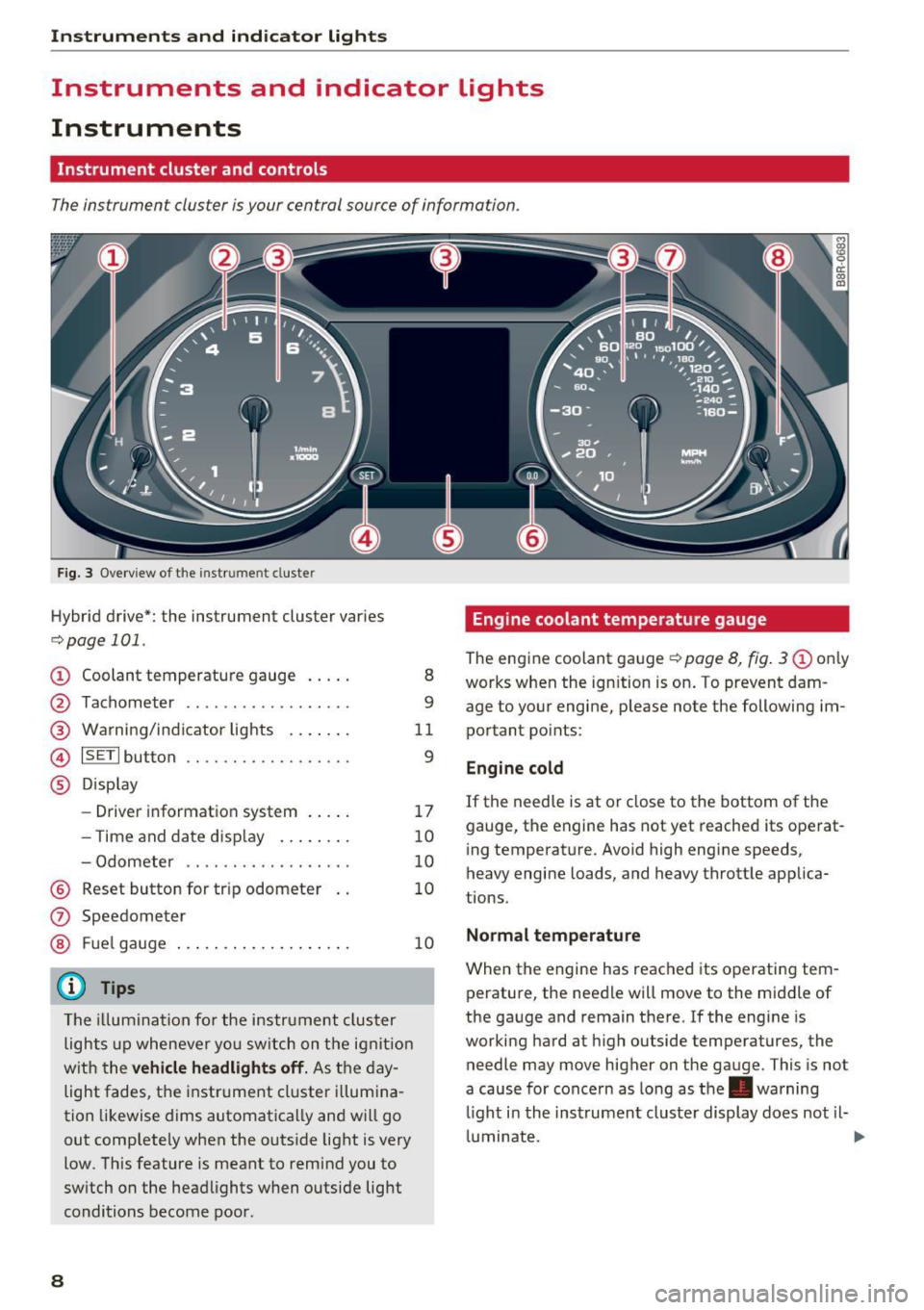
Instruments and indicator lights
Instruments and indicator Lights
Instruments
Instrument cluster and controls
The instrument cluster is your central source of information.
Fig. 3 Overview of the instr ume nt cluste r
Hybrid drive*: the instrument cluster varies
c:;,page 101.
CD Coolant temperature gauge
@
®
©
®
Tachometer .............. ... .
Warning/indicator lights ...... .
ISETI button .... .. .. ..... .... .
Display
- Driver information system .... .
- T ime and date display ....... .
- Odometer .... .... ....... .. .
® Reset button for trip odometer
(J) Speedometer
® Fuel gauge
(D Tips
The illum inatio n for the instrument cluster
lights up whenever yo u switch on the ignit ion
w ith the
vehicle headlights off. As the day
light fades, the instrument cluster illumina
tion likewise dims automatica lly and will go
out comp letely when the outside light is very
low . This feature is meant to remind you to
switch on the headlights when outside light
conditions become poor .
8
8
9
11
9
17
10
10
10
10
Engine coolant temperature gauge
The engine coolant gauge¢ page 8, fig. 3 CD on ly
works when the ign ition is on . To prevent dam
age to your engine, please note the following im
portant points:
Engine cold
If the needle is at or close to the bottom of the
gauge, the engine has not yet reached its operat
ing temperature. Avoid high engine speeds,
heavy engine loads, and heavy throttle applica
tions .
Normal temperature
When the engine has reached its operating tem
perature, the needle will move to the middle of
the gauge and remain there.
If the engine is
working hard at high outside temperatures, the
needle may move higher on the gauge . This is not
a cause for concern as long as the . warning
li ght i n the inst rument cluste r display does not il-
luminate . ..,.
Page 11 of 296
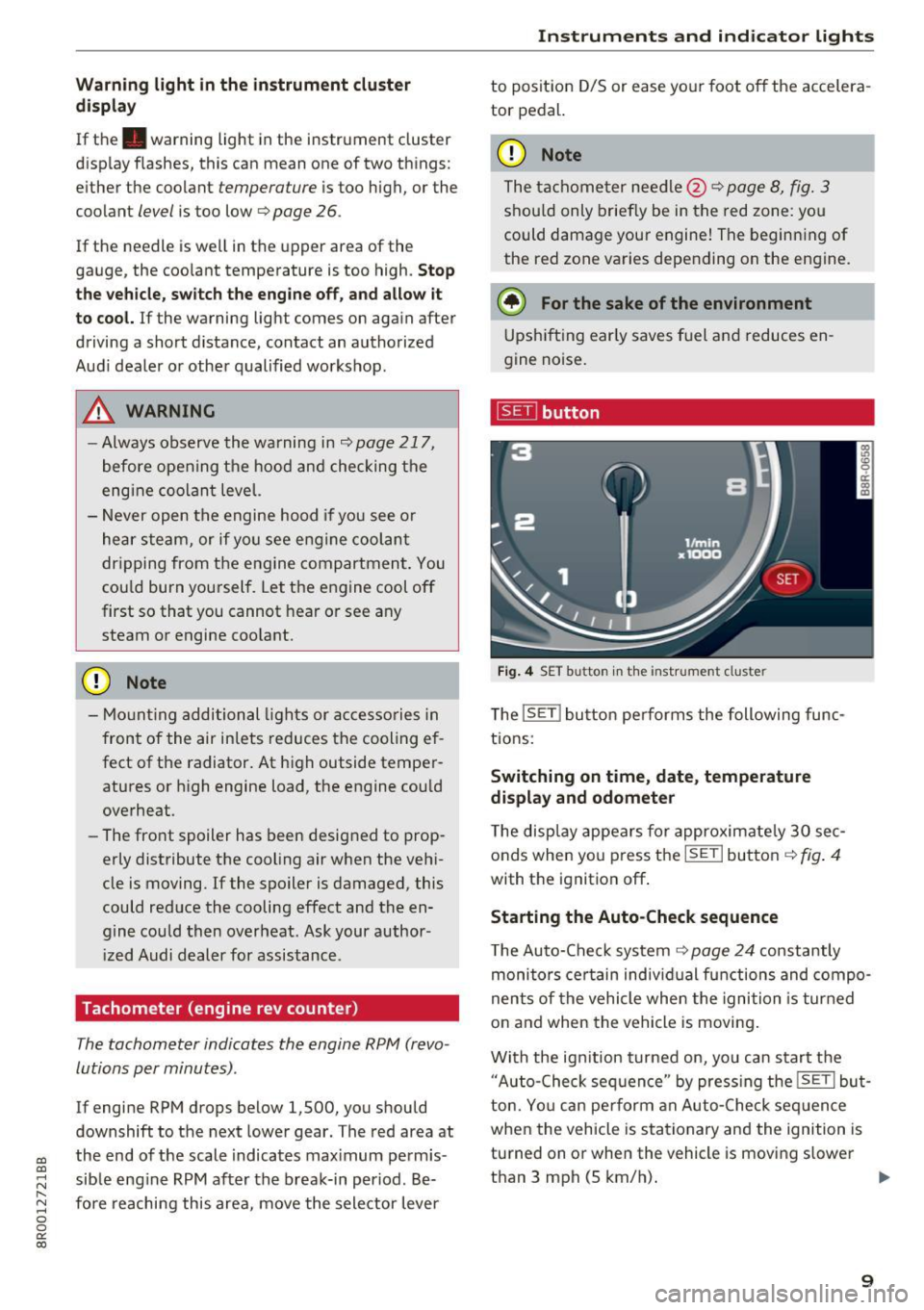
a,
a,
..... N r-N ..... 0 0
0:
co
Warning light in the instrument cluster
display
If the . warning light in the instrument cluster
display flashes, this can mean one of two things:
either the coolant
temperature is too high, or the
coolant
level is too low~ page 26.
If the needle is well in the upper area of the
gauge, the coolant temperature is too high.
Stop
the vehicle, switch the engine off, and allow it
to cool. If the warning light comes on again after
driving a short distance, contact an authorized
Audi dealer or other qualified workshop .
_& WARNING
- Always observe the warning in~ page 217,
before opening the hood and checking the
engine coolant level.
- Never open the engine hood if you see or
hear steam, or if you see engine coolant
dr ipping from the engine compartment. You
cou ld burn yourself. Let the engine cool off
first so that you cannot hear or see any
steam or engine coo lant.
CD Note
- Mounting additional lights or accessories in
front of the air inlets reduces the cooling ef
fect of the radiator. At high outside temper
atures or high engine load, the engine could
overheat.
- The front spoiler has been designed to prop
erly distribute the cooling air when the vehi
cle is moving. If the spoiler is damaged, this
could reduce the cooling effect and the en
gine could then overheat. Ask your author
iz ed Audi dealer for assistance.
Tachometer (engine rev counter)
The tachometer indicates the engine RPM (revo
lutions per minutes) .
If engine RPM drops below 1,500, you should
downshift to the next lower gear. The red area at
the end of the scale indicates max imum permis
sible engine RPM after the break-in period . Be
fore reaching this area, move the selector lever
Instruments and indicator lights
to posit ion D/S or ease your foot off the accelera
tor pedal.
CD Note
The tachometer need le@ ~ page 8, fig. 3
shou ld only briefly be in the red zone: you
could damage your engine! The beginning of
the red zone varies depending on the engine.
@ For the sake of the environment
Upshifting early saves fuel and reduces en
gine noise.
~ button
Fig. 4 SET button in the instrument cluster
The !SET ! button performs the following func
tions:
Switching on time, date, temperature
display and odometer
The display appears for approximately 30 sec
onds when you press the
ISETI button ~fig . 4
with the ignition off .
Starting the Auto-Check sequence
The Auto-Check system ~ page 24 constantly
monitors certain individual functions and compo
nents of the vehicle when the ignition is turned
on and when the vehicle is moving.
With the ignit ion turned on, you can start the
"Auto-Check sequence" by press ing the
!SE TI but
ton. You can pe rform an Auto-Check seq uence
when the vehicle is stationary and the ignition is
turned on or when the vehicle is moving slower
than 3 mph (5 km/h).
IIJ,,,
9
Page 27 of 296
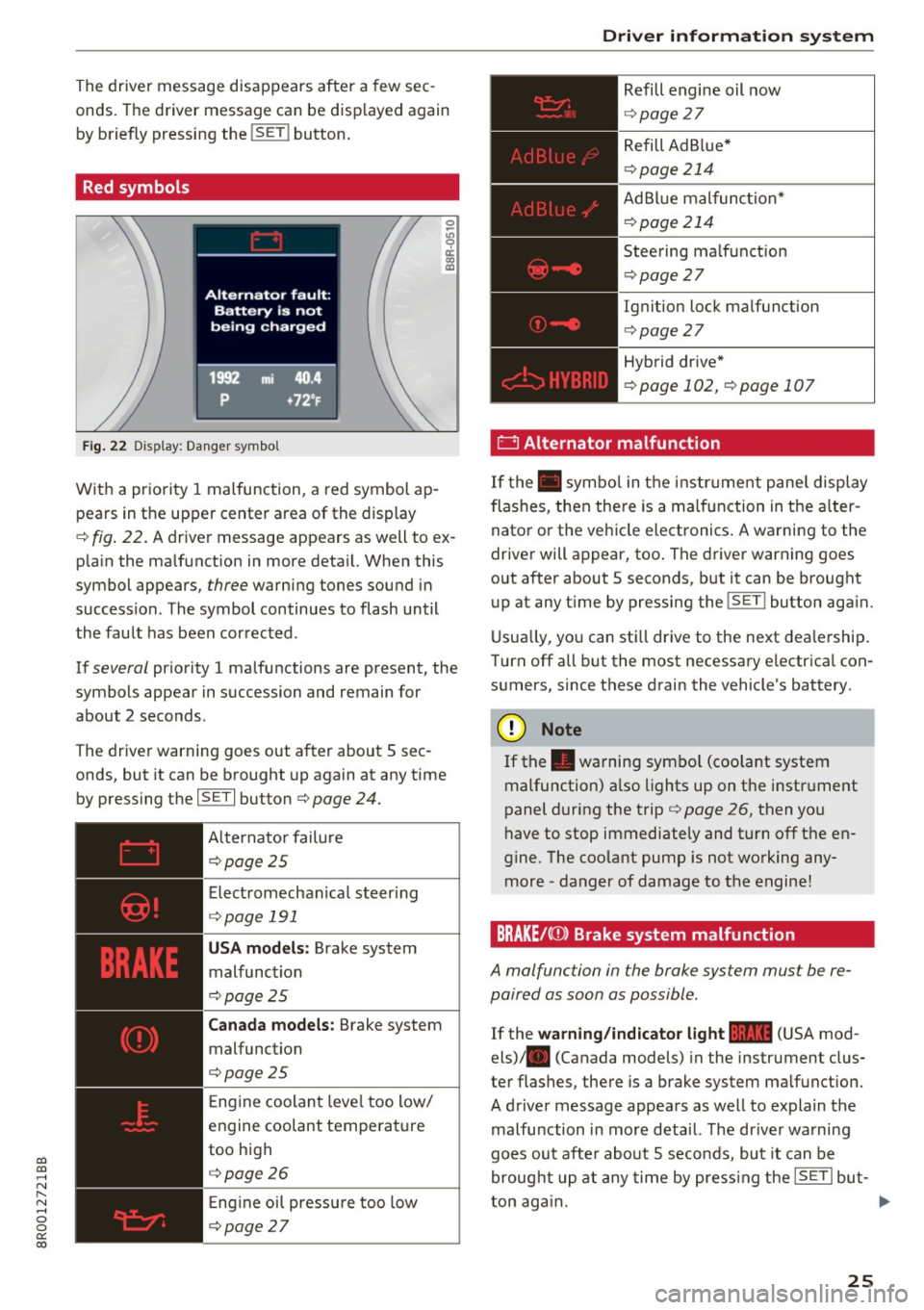
CD
CD
.... N ,-... N ..... 0 0 c:<: 00
The driver message disappears after a few sec
onds. The driver message can be disp layed again
by briefly pressing the
! SE T! button .
Red symbols
Fig . 22 Display: Danger symbol
With a priority 1 malfunction, a red symbol ap
pears in the upper center area of the display
0 ~
"' 9 a: CX) IX)
c:::> fig. 22 . A driver message appears as well to ex
p la in the ma lfunction in more deta il. When this
symbol appears,
three warning tones sound in
succession. The symbol continues to flash until
the fault has been corrected .
If
several pr iority 1 malfunctions are present, the
symbols appear in succession and remain for
about 2 seconds .
The driver warning goes out after about 5 sec
onds, but it can be brought up again at any time
by pressing the
ISETI button c:> page 24.
Alternator failure
c:::> page 2 5
Electromechanical steering
c:::> page 191
USA models : Brake system
malfunction
c:>page 25
Canada models: Brake system
malfunction
c:> page 25
E ng ine coolant level too low/
engine coolant temperature
too high
c:::> page 2 6
En gin e o il pressure too low
c:::> page 2 7
Driver information system
Refill engine oil now
c:::> page 2 7
Refill Ad B lue*
c:> page 214
AdBlue malfunction*
c:::> page 214
Steering malfunction
c:::> page 2 7
Ignition lock malfunction
c:> page 27
Hybrid dr ive*
c:> page 102, c:> page 107
' 0 Alternator malfunction
If the . symbo l in the instr um ent panel display
flashes, then the re is a malfunction in the alter
nator or the vehicle electronics . A warning to the
driver will appear, too . The driver warning goes
out after about 5 seconds, but it can be brought
up at any t ime by pressing the
!SET ! button aga in.
Usually, you can still drive to the next dea lership .
T urn off all but the most necessary e lectrica l con
sumers, since these drain the vehicle's battery.
(D Note
If the . warning symbo l (coolant system
malfunction) also lights up on the instrument
panel during the trip
c:> page 26, then you
have to stop immediately and turn off the en
gine. The coolant pump is not working any
more -danger of damage to the engine!
BRAKE/C(D) Brake system malfunction
A ma/function in the brake system must be re
paired as soon as possible .
If the warning/indicator light 11111 (USA mod
els) . (Canada models) in the instrument clus
ter flashes, there is a brake system malfunction.
A driver message appears as well to explain the
malfu nction in more detail. The driver wa rning
goes out after about 5 seconds, but it can be
brought up at any time by pressing the
ISETI but-
ton again. ..,.
25
Page 28 of 296

Driver information s ystem
Stop vehicle and check brake fluid level
.,. Stop the vehi cle.
.,. Check the brake f luid leve l¢
pag e 224 .
.,. Seek professional assistance if necessary.
Warning! Fault in brake system. Contact
work shop
.,. Drive carefu lly to the nearest authorized A udi
dealer or other qualified workshop and have
the malfunction corrected ¢
,&..
Parking brake system fault! See owner 's
manual
.,. If this symbol appears when the ve hicle is sta
tionary or after the ignition is turned on, check
to see if the park ing brake can be released.
Drive to an authori zed Audi dealer or other
qualified workshop as soon as poss ible and
have the malfunction corrected . If the parking
brake cannot be opened, then take it to an ex
pert at a n author ized Audi dealer.
.,. If the symbol appears while you are d riving, i t is
poss ible th at t he traction co ntro l or the emer
gency brake has malfunctioned . It is possib le
that the parking brake cannot be applied .
It is
also possible that th e parking brake cannot be
released after it has been applied. Drive to an
authori zed Aud i dea ler or other qualified work
shop to have the malfunct io n corrected.
If the ABS system malfunct ions, the ABS warn
ing/indicator light illuminates together with the
brake system malfunction warn ing/ indicator
light ¢.&. .
A WARNING
-Always observe the warnings in
¢page 217, before opening the hood and
c he ck ing the b rake fl uid .
- Driving with low brake fl uid is a safety haz
ar d. Stop the car and get professional ass is
tan ce.
- If the .. (USA models) . (Canada mod
els) brake system i ndic ator lig ht tu rns on to
ge ther wit h the ABS and ES C i ndi ca to r
ligh ts, the ABS/ ESC regula ting func tion may
have failed . Functions that stab ilize the ve
hicle a re no longe r available. This could
26
cause the vehicle to swerve and increase the
r isk of sliding. Drive caref ully to the nearest
author ized Audi dealer or other qualified
workshop and have the malfunct io n correct
ed.
- L Engine cooling system malfunction
A malfunction in the engine cooling system mu st
be repaired as soon as possible.
If the . symbol flashes in the disp lay, either the
engine coo lant
temperature is too high or the en
gine coolant
level is too low. A driver message
appears as we ll to expla in the malfunct ion in
more detail. The dr iver warn ing goes out after
about 5 seconds, but it can be b rought up at any
time by p ressing the
IS ET I button agai n.
Turn off engine and check coolant level
.,. Pull off the road .
.,. Stop the vehicle .
.,. Turn off the engine .
.,. Check coolant level¢
page 223 .
.,. Add coolant if necessary ~ page 223.
.,. Continue dr iv ing only after the engine coolant
wa rning/i nd ic ator light goes out .
.,. Contact your authori zed A udi dealer for assis
tance if ne cessa ry.
If the engine coo lant level is correct, then t he ra
diato r fan may be the cause of t he malfunc tion.
A WARNING ~
- If you r vehicle should break down fo r me-
chan ica l or othe r reasons, park at a safe dis
tance from mov ing traffic, turn off the en
gine and turn on the hazard warning lights
¢ page 51, Emergency flashers.
- Never open the hood if you see or hear
steam or coolant escaping from the engine
compartment -you risk being scalded. Wait
until you can no longer see or hear steam or
coo lant escaping .
- The engine compartment of any veh icle is a
dangerous area. Before you perfo rm any
work i n the engine compartment, turn of
t he engine and allow i t to cool. Follow the
warn ing stickers
¢ page 217. ~
Page 204 of 296
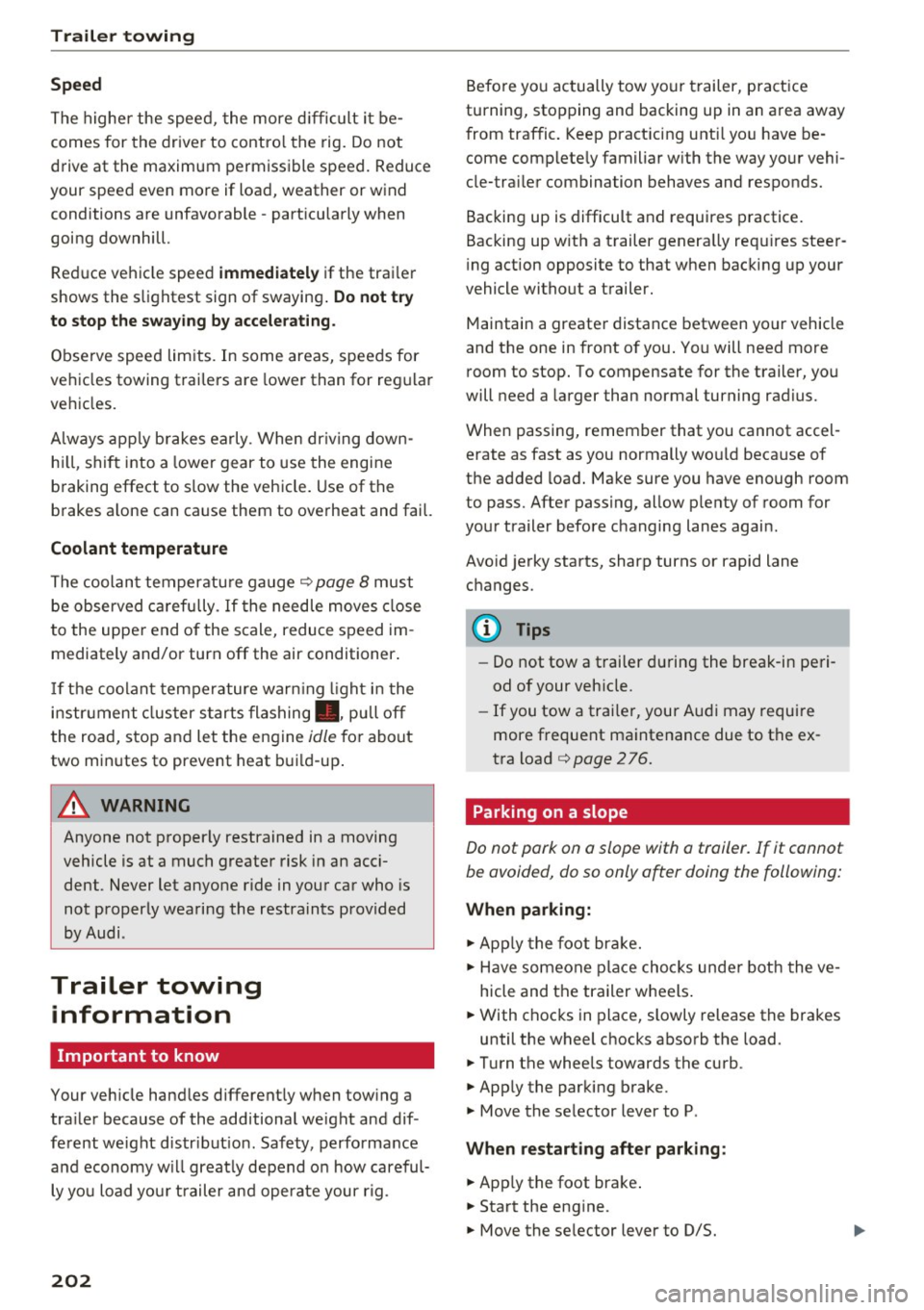
Trailer towing
Sp eed
The higher the speed, the more d ifficult it be
comes for the driver to contro l the rig. Do not
dr ive at the maximum permissible speed. Reduce
your speed even more if load, w eather or wind
conditions are unfavorable -particularly when
going downhill.
Red uce vehicle speed
immediatel y if the trai le r
shows the s lightest sign of swaying .
Do not try
to stop the swayin g by ac cele rating.
Observe speed limits . In some areas, speeds for
vehicles towing trailers are lower than for reg ular
ve hicles.
A lways apply b rakes early . When dr iving down
hi ll, shi ft into a lower gear to use the engine
braking effect to slow the vehicle. Use of the
brakes a lone can cause them to overheat and fail.
Coolant temperature
The coolant temperatu re gauge ¢ page 8 must
be observed ca refully . If the needle moves close
to the upper end of the scale, reduce speed im
mediately and/or turn off the air conditioner .
I f t he coolan t temperature warn ing light i n the
instr ument cluster s tarts flashing ., pull off
the road, stop and let the engine
idle for about
two minutes to prevent heat bu ild-up .
A WARNING
Anyone not properly restrained in a moving
vehicle is at a much greater risk in an acci
dent . Never let anyone ride in your car who is
not properly wearing the restraints provided
by Audi .
Trailer towing
information
Important to know
Your veh icle hand les different ly when tow ing a
tra iler because of the additional weight and dif
fe rent weight d istr ibut ion . Safety, performance
and economy w ill great ly depend on how careful
ly you load you r trailer and operate your rig .
202
Before you actually tow your trailer, practice
turning, stopping and backing up in an area away
from traffic . Keep pract icing unt il yo u h ave be
come comp lete ly familiar w ith the way your vehi
cle-tra iler combination behaves and responds.
Backing up is difficult and requires practice .
Backing up w ith a trailer generally req uires steer
i ng action opposite to that when backing up your
vehicle without a trailer.
Maintain a greater distance between your vehicle
and the one in front of you . You will need more
room to stop. To compensate for the trailer, you
will need a larger than normal turning radius.
When passing, remember that you cannot accel erate as fast as you normally wou ld because of
the added load. Make sure you have enough room
to pass. After passing, allow p lenty of room for
your trailer before changing lanes again.
Avo id jerky starts, sharp turns or rapid lane
changes.
(D Tips
- Do not tow a trailer during the break-in peri
od of your veh icle.
- If you tow a trai ler, your Audi may requi re
more frequent maintenance due to the ex
tra load ¢
page 2 76.
' Parking on a slope
Do not park on a slope with a trailer. If it cannot
be avoided, do so only after doing the following:
When parking:
.,. App ly the foot bra ke .
.,. Have someone place cho cks under bot h the ve
hicle and the trailer wheels .
.,. With choc ks in place, slowly release the brakes
until the wheel chocks absorb the load.
.,. Turn the wheels towards the curb .
.,. App ly the parking brake .
.,. Move the selector lever to P .
When restarting after parking :
.,. App ly the foot brake .
.,. Start the eng ine .
.,. Move the se lector lever to D/S.
Page 220 of 296
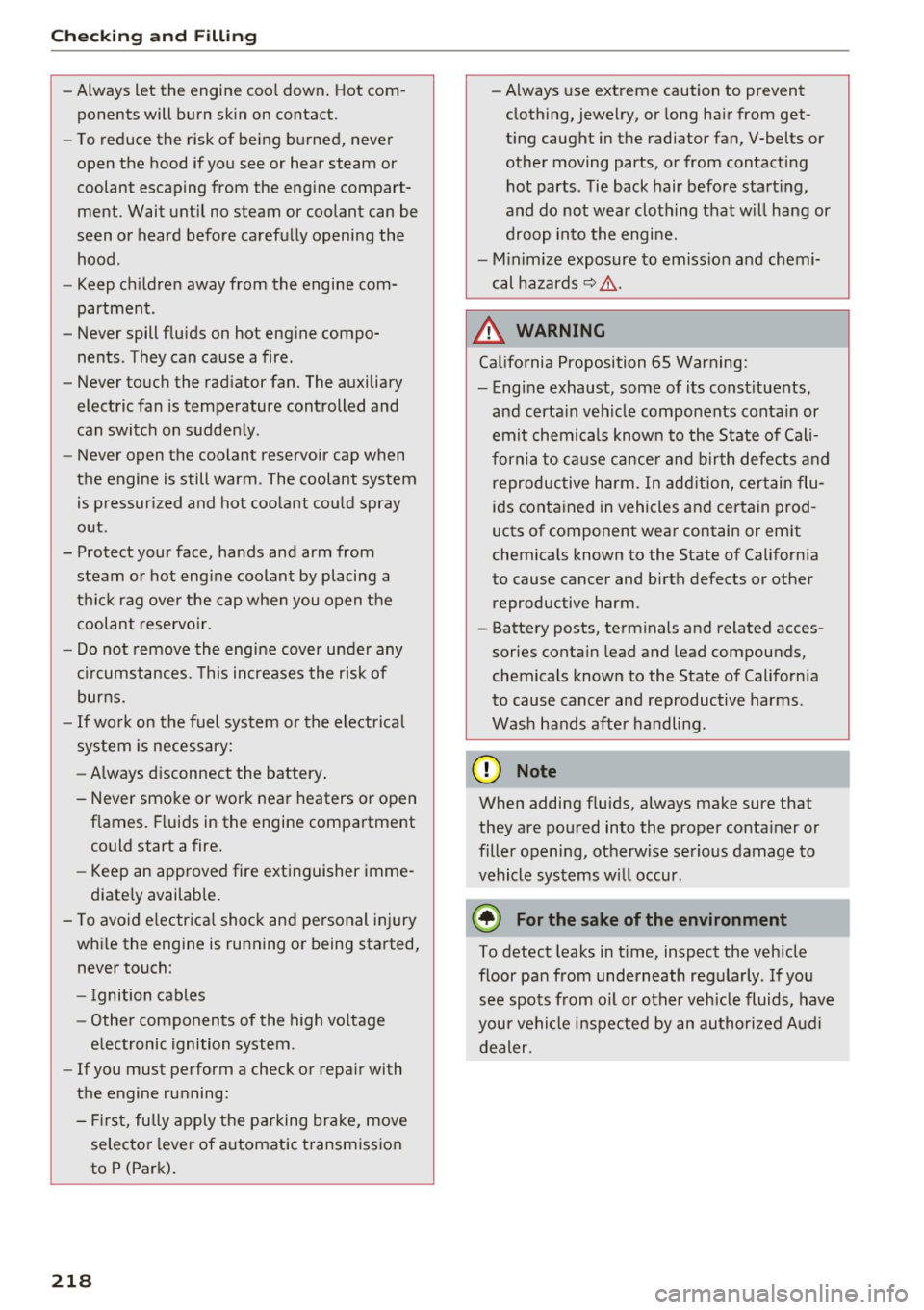
Checking and Filling
-Always let the engine cool down. Hot com
ponents will burn skin on contact .
- To reduce the risk of being burned, never
open the hood if you see or hear steam or
coolant escaping from the engine compart
ment. Wait until no steam or coolant can be
seen or heard before carefully opening the
hood.
- Keep children away from the engine com
partment.
- Never spill fluids on hot engine compo
nents . They can cause a fire.
- Never touch the radiator fan. The auxiliary
electric fan is temperature controlled and
can switch on suddenly.
- Never open the coolant reservoir cap when
the engine is still warm. The coolant system
is pressurized and hot coolant could spray
out .
- Protect your face, hands and arm from steam or hot engine coolant by placing a
thick rag over the cap when you open the coolant reservoir.
- Do not remove the engine cover under any
circumstances . This increases the risk of
burns.
- If work on the fuel system or the electrical
system is necessary:
- Always disconnect the battery.
- Never smoke or work near heaters or open flames. Fluids in the engine compartment
could start a fire.
- Keep an approved fire extinguisher imme
diately available.
- To avoid electrical shock and personal injury
while the engine is running or being started, never touch:
- Ignition cables
- Other components of the high voltage
electronic ignition system .
- If you must perform a check or repair with
the engine running:
- First, fully apply the parking brake, move
selector lever of automatic transmission
to P (Park).
218
- Always use extreme caution to prevent
clothing, jewelry, or long hair from get
ting caught in the radiator fan, V-belts or
other moving parts, or from contacting hot parts . Tie back hair before starting,
and do not wear clothing that will hang or
droop into the engine.
- Minimize exposure to emission and chemi
cal hazards
~ &.
&, WARNING
California Proposition 65 Warning:
- Engine exhaust, some of its constituents,
and certain vehicle components contain or
emit chemicals known to the State of Cali
fornia to cause cancer and birth defects and
reproductive harm. In addition, certain flu
ids contained in vehicles and certain prod
ucts of component wear contain or em it
chemicals known to the State of California
to cause cancer and birth defects or other
reproductive harm .
- Battery posts, terminals and related acces sories contain lead and lead compounds,
chemicals known to the State of California
to cause cancer and reproductive harms .
Wash hands after handling.
('.!) Note
When adding fluids, always make sure that
they are poured into the proper container or
filler opening, otherwise serious damage to
vehicle systems will occur.
@ For the sake of the environment
To detect leaks in time, inspect the vehicle
floor pan from underneath regularly . If you
see spots from oil or other vehicle fluids, have
your vehicle inspected by an authorized Audi dealer.
Page 279 of 296
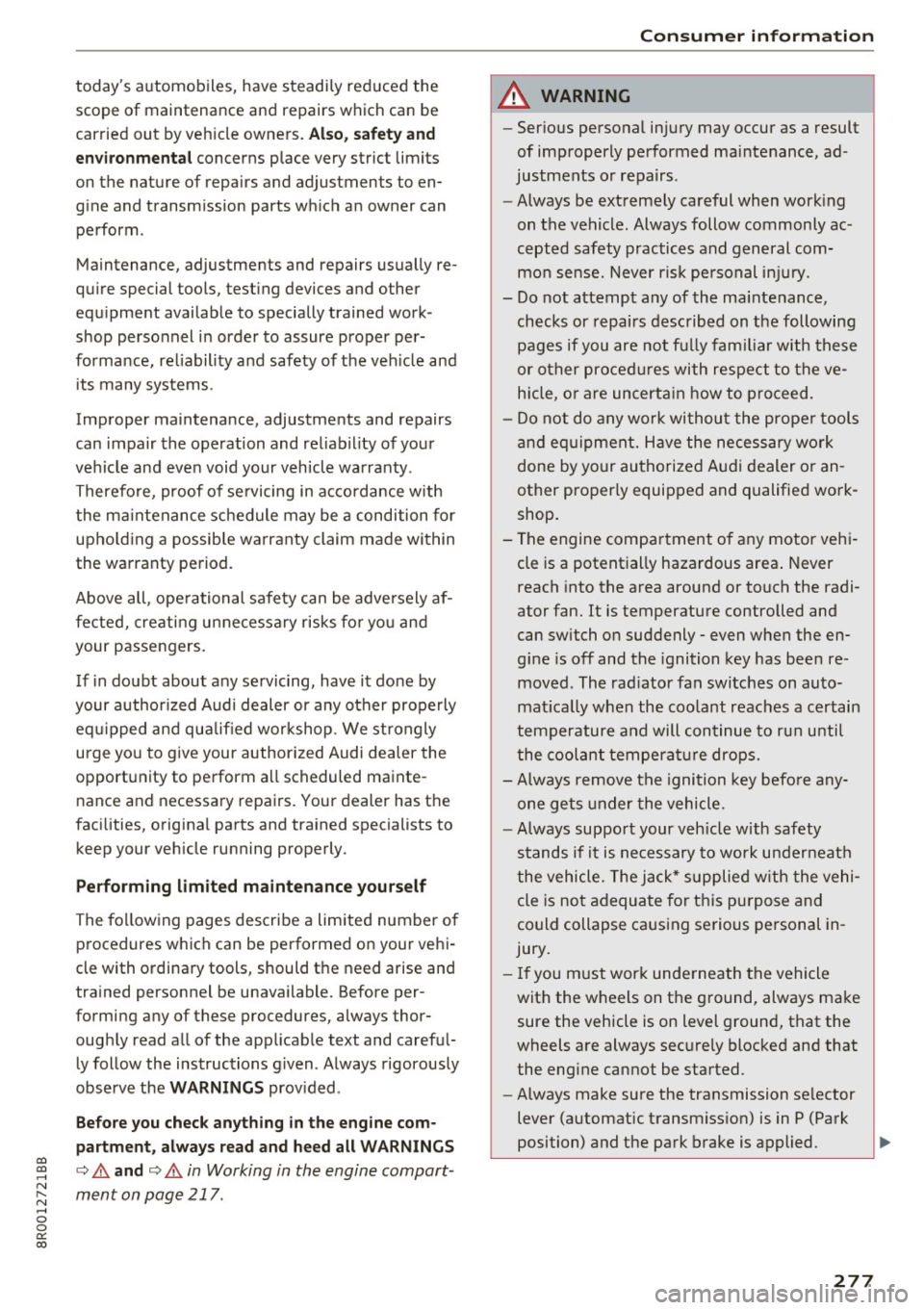
CD
CD
.... N ,-... N ..... 0 0 C<'. 00
today's automobiles, have steadily reduced the
scope of maintenance and repairs which can be
carried out by vehicle owners.
Also, safety and
environmental
concerns place very strict limits
on the nature of repairs and adjustments to en
gine and transmission parts which an owner can perform .
Maintenance, adjustments and repairs usually re
quire special tools, testing devices and other
equipment available to specially trained work
shop personnel in order to assure proper per
formance, reliability and safety of the vehicle and
its many systems.
Improper maintenance, adjustments and repairs
can impair the operation and reliability of your
vehicle and even void your vehicle warranty .
Therefore, proof of servicing in accordance with
the maintenance schedule may be a condition for upholding a possible warranty claim made within
the warranty period.
Above all , operational safety can be adversely af
fected, creating unnecessary risks for you and
your passengers.
If in doubt about any servicing, have it done by
your authorized Audi dealer or any other properly equipped and qualified workshop. We strongly urge you to give your authorized Audi dealer the
opportunity to perform all scheduled mainte nance and necessary repairs. Your dealer has the
facilities, original parts and trained specialists to keep your vehicle running properly .
Performing limited maintenance yourself
The following pages describe a limited number of
procedures which can be performed on your vehi
cle with ordinary tools, should the need arise and
trained personnel be unavailable. Before per
forming any of these procedures, always thor
oughly read all of the applicable text and careful ly follow the instructions given . Always rigorously
observe the
WARNINGS provided .
Before you check anything in the engine com
partment, always read and heed all WARNINGS
c::> .&. and c::> .&. in Working in the engine compart
ment on page 217 .
Consumer information
A WARNING
-Serious personal injury may occur as a result
of improperly performed maintenance, ad
justments or repairs .
- Always be extremely careful when working
on the vehicle. Always follow commonly ac
cepted safety practices and general com
mon sense. Never risk personal injury.
- Do not attempt any of the maintenance,
checks or repairs described on the following pages if you are not fully familiar with these
or other procedures with respect to the ve hicle, or are uncertain how to proceed.
- Do not do any work without the proper tools
and equipment. Have the necessary work
done by your authorized Audi dealer or an
other properly equipped and qualified work
shop.
- The engine compartment of any motor vehi cle is a potentially hazardous area. Never
reach into the area around or touch the radi
ator fan.
It is temperature controlled and
can switch on suddenly - even when the en
gine is off and the ignition key has been re
moved . The radiator fan switches on auto
matically when the coolant reaches a certain
temperature and will continue to run until
the coolant temperature drops.
- Always remove the ignition key before any
one gets under the vehicle.
- Always support your vehicle with safety
stands if it is necessary to work underneath
the vehicle . The jack* supplied with the vehi
cle is not adequate for this purpose and
could collapse causing serious personal in
jury.
- If you must work underneath the vehicle
with the wheels on the ground, always make
sure the vehicle is on level ground, that the
wheels are always securely blocked and that the engine cannot be started.
- Always make sure the transmission selector
lever (automatic transmission) is in P (Park
position) and the park brake is applied.
277
Page 286 of 296
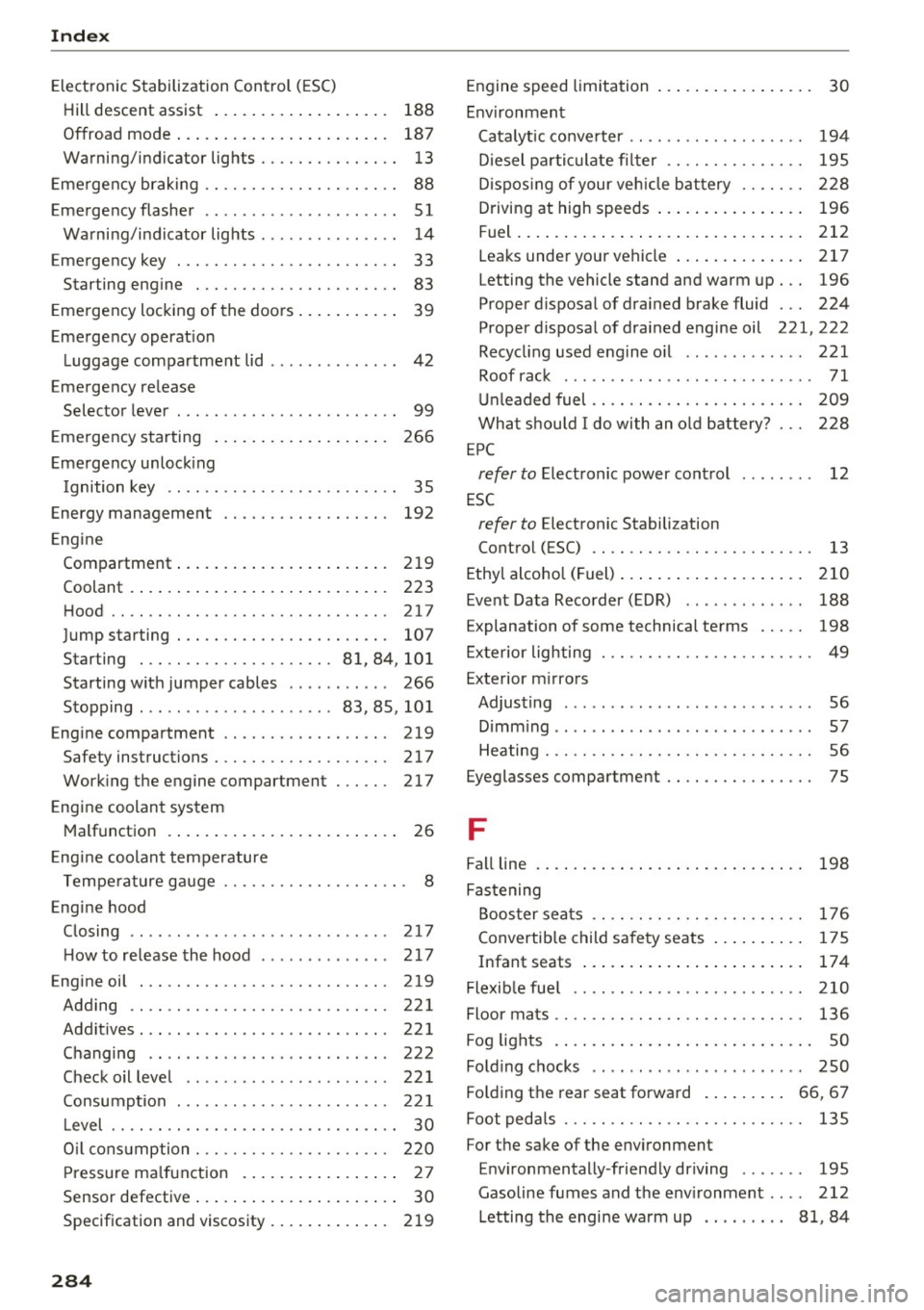
Index
Electronic Stabilization Control (ESC) Hill descent assist . . . . . . . . . . . . . . . . . . .
188
Offroad mode . . . . . . . . . . . . . . . . . . . . . . . 187
Warning/indicator lights . . . . . . . . . . . . . . . 13
Emergency braking . . . . . . . . . . . . . . . . . . . . . 88
Emergency flasher . . . . . . . . . . . . . . . . . . . . . S 1
Warning/indicator lights . . . . . . . . . . . . . . .
14
Emergency key . . . . . . . . . . . . . . . . . . . . . . . . 33
Starting engine . . . . . . . . . . . . . . . . . . . . . . 83
Emergency locking of the doors. . . . . . . . . . . 39
Emergency operation
Luggage compartment lid . . . . . . . . . . . . . .
42
Emergency release
Selector lever . . . . . . . . . . . . . . . . . . . . . . . .
99
Emergency starting . . . . . . . . . . . . . . . . . . . 266
Emergency unlocking
Ignition key . . . . . . . . . . . . . . . . . . . . . . . . .
35
Energy management . . . . . . . . . . . . . . . . . . 192
Engine
Compartment ................... ... .
219
Coolant . . . . . . . . . . . . . . . . . . . . . . . . . . . . 223
Hood ...... .. ................... ... 217
Jump starting . . . . . . . . . . . . . . . . . . . . . . . 107
Starting ... .. ................ 81, 84 , 101
Starting with jumper cables . . . . . . . . . . .
266
Stopping ... .. .. ... .... ...... . 83, 85, 101
Engine compartment ........... .... .. . 219
Safety instructions . . . . . . . . . . . . . . . . . . . 217
Working the engine compartment ...... 217
Engine coolant system
Malfunction . . . . . . . . . . . . . . . . . . . . . . . . .
26
Engine coolant temperature
Temperature gauge . . . . . . . . . . . . . . . . . . . . 8
Engine hood
Closing . . . . . . . . . . . . . . . . . . . . . . . . . . . .
217
H ow to release the hood . . . . . . . . . . . . . . 217
Engine oil . .. .. ................... ... 219
Adding . . . . . . . . . . . . . . . . . . . . . . . . . . . . 221
Additives. .. .. .. ... .. ..... ..... .. .. . 221
Changing . . . . . . . . . . . . . . . . . . . . . . . . . . 222
Check oil level . . . . . . . . . . . . . . . . . . . . . . 221
Consumption . . . . . . . . . . . . . . . . . . . . . . . 221
Level . . . . . . . . . . . . . . . . . . . . . . . . . . . . . . . 30
O il consumption . . . . . . . . . . . . . . . . . . . . . 220
Pressure malfunction . . . . . . . . . . . . . . . . . 27
Sensor defective . . . . . . . . . . . . . . . . . . . . . . 30
Specification and viscosity......... ... . 219
284
Engine speed limitation . . . . . . . . . . . . . . . . . 30
Environment
Catalyt ic converter . . . . . . . . . . . . . . . . . . .
194
Diesel particulate filter . . . . . . . . . . . . . . . 195
Dispos ing of your veh icle battery . . . . . . . 228
Driving at high speeds . . . . . . . . . . . . . . . . 196
Fuel......... ... .. .. ............... 212
Leaks under your vehicle . . . . . . . . . . . . . . 217
Letting the vehicle stand and warm up. . . 196
Proper disposal of drained brake fluid 224
Proper disposal of drained engine oil 221,222
Recycling used engine o il . . . . . . . . . . . . . 221
Roof rack . . . . . . . . . . . . . . . . . . . . . . . . . . . 71
Unleaded fuel . . . . . . . . . . . . . . . . . . . . . . . 209
What shou ld I do with an old battery? 228
EPC
refer to Electronic power control . . . . . . . . 12
ESC
refer to Electronic Stabilization
Control (ESC) . . . . . . . . . . . . . . . . . . . . . . . .
13
Ethyl alcohol (Fuel) . . . . . . . . . . . . . . . . . . . . 210
Event Data Recorder (EDR) . . . . . . . . . . . . . 188
Explanation of some technical terms . . . . . 198
Exterior lighting . . . . . . . . . . . . . . . . . . . . . . . 49
Exterior mirrors Adjusting . . . . . . . . . . . . . . . . . . . . . . . . . . .
56
D ' . rmmrng ...... .. ... .... ....... .... .. 57
Heating . . . . . . . . . . . . . . . . . . . . . . . . . . . . . 56
Eyeglasses compartment . . . . . . . . . . . . . . . . 75
F
Fall line 198
Fastening
Booster seats . . . . . . . . . . . . . . . . . . . . . . .
176
Convertible child safety seats . . . . . . . . . . 175
Infant seats . . . . . . . . . . . . . . . . . . . . . . . . 174
Flexib le fue l . . . . . . . . . . . . . . . . . . . . . . . . . 210
Floor mats . . . . . . . . . . . . . . . . . . . . . . . . . . . 136
Fog lights . . . . . . . . . . . . . . . . . . . . . . . . . . . . 50
Folding chocks . . . . . . . . . . . . . . . . . . . . . . . 250
Folding the rear seat forward . . . . . . . . . 66, 67
Foot pedals . . . . . . . . . . . . . . . . . . . . . . . . . .
135
For the sake of the environment
Environmentally -friendly driving . . . . . . .
195
Gasoline fumes and the environment .. .. 212
Letting the engine warm up . . . . . . . . . 81 , 84
Page 287 of 296
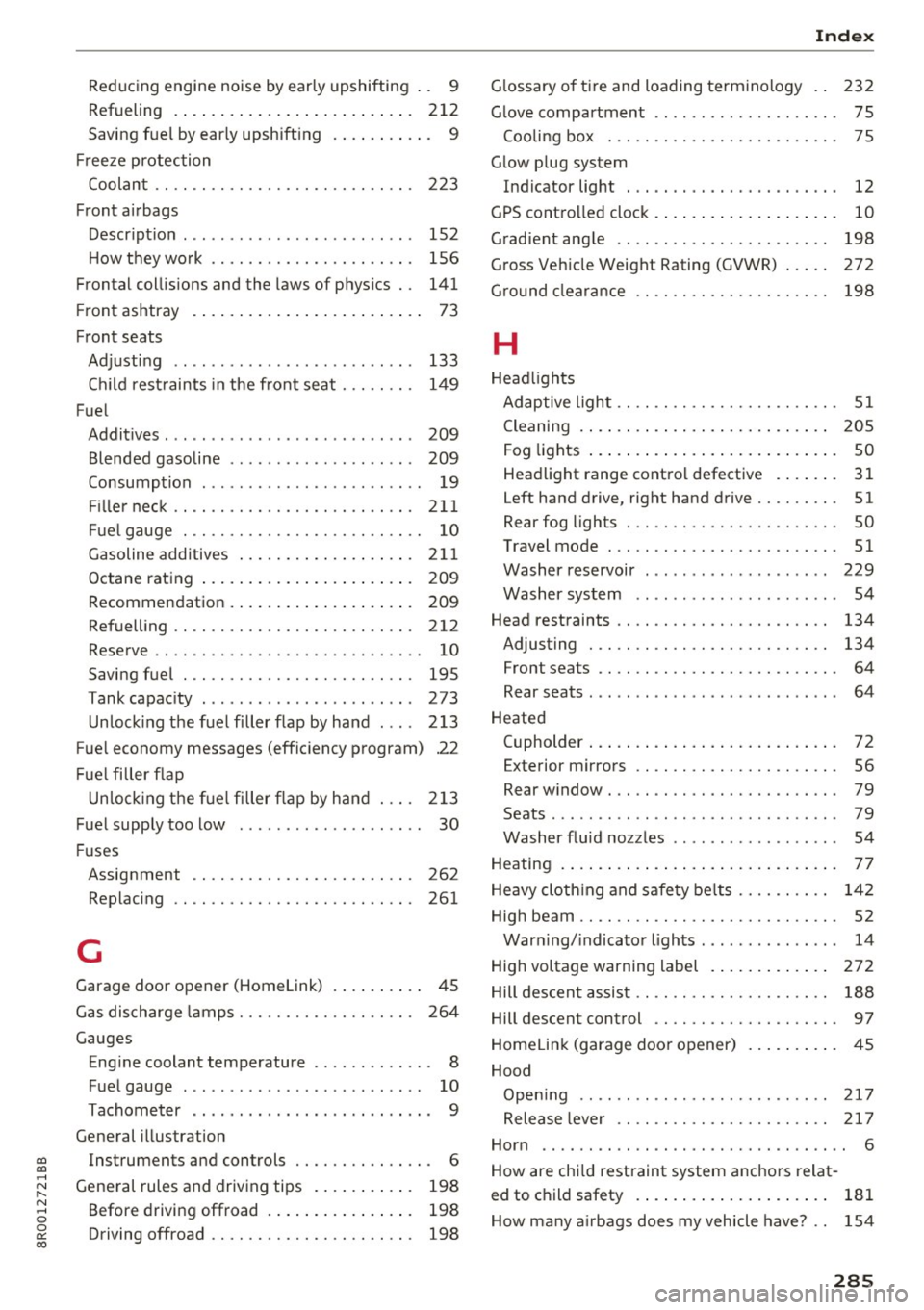
Reducing engine noise by early upshifting . . 9
Refueling .. .. ............... .. .... . 212
Saving fuel by early upshift ing . . . . . . . . . . . 9
Freeze protection
Coolant . . . . . . . . . . . . . . . . . . . . . . . . . . . . 223
Front airbags Description . . . . . . . . . . . . . . . . . . . . . . . . . 152
Howtheywork .... . .......... .. .. .. . 156
Frontal collisions and the laws of physics . . 141
Fr ont ashtray . . . . . . . . . . . . . . . . . . . . . . . . . 73
Front seats Adjusting . . . . . . . . . . . . . . . . . . . . . . . . . . 133
Ch ild restraints in the front seat . . . . . . . . 149
Fuel Additives. . . . . . . . . . . . . . . . . . . . . . . . . . . 209
Blended gasoline . . . . . . . . . . . . . . . . . . . . 209
Consumption . . . . . . . . . . . . . . . . . . . . . . . . 19
Filler neck . . . . . . . . . . . . . . . . . . . . . . . . . . 211
Fu el gauge . . . . . . . . . . . . . . . . . . . . . . . . . . 10
Gasoline additives . . . . . . . . . . . . . . . . . . . 211
Octane rating . . . . . . . . . . . . . . . . . . . . . . . 209
Recommendation . . . . . . . . . . . . . . . . . . . . 209
Refuelling . . . . . . . . . . . . . . . . . . . . . . . . . . 212
Reserve . . . . . . . . . . . . . . . . . . . . . . . . . . . . . 10
Saving fuel . . . . . . . . . . . . . . . . . . . . . . . . . 195
T ank capacity . . . . . . . . . . . . . . . . . . . . . . . 273
Unlocking the fuel filler flap by hand . . . . 213
Fuel economy messages (efficiency prog ram) .22
Fuel filler flap
Un lock ingthefuelfillerflapbyhand . .. . 213
Fuel supply too low . . . . . . . . . . . . . . . . . . . . 30
F uses
Assignment . . . . . . . . . . . . . . . . . . . . . . . . 262
Replacing . . . . . . . . . . . . . . . . . . . . . . . . . . 261
G
Garage door op ener (Home link) . . . . . . . . . . 45
Gas discharge lamps . . . . . . . . . . . . . . . . . . . 264
Gauges Engine coolant temperature . . . . . . . . . . . . . 8
Fuel gauge . . . . . . . . . . . . . . . . . . . . . . . . . . 10
Tachometer . . . . . . . . . . . . . . . . . . . . . . . . . . 9
General illustration
~ Instruments and controls . . . . . . . . . . . . . . . 6
....
~ General rules and driving tips . . . . . . . . . . . 198
N 8 Befor e driving offroad . . . . . . . . . . . . . . . . 198
~ Driving off road . . . . . . . . . . . . . . . . . . . . . . 198 00
Index
Glossary of tire and loading terminology . . 232
Glove compartment . . . . . . . . . . . . . . . . . . . . 75
Coo ling box . . . . . . . . . . . . . . . . . . . . . . . . . 75
Glow plug system Indicator light . . . . . . . . . . . . . . . . . . . . . . . 12
GPS controlled clock . . . . . . . . . . . . . . . . . . . . 10
Gradient ang le . . . . . . . . . . . . . . . . . . . . . . . 198
Gross Vehicle Weight Rating (GVWR) . . . . . 272
Ground clearance 198
H
Headlights
Adaptive light . . . . . . . . . . . . . . . . . . . . . . . . S 1
Cleaning . . . . . . . . . . . . . . . . . . . . . . . . . . . 205
Fog lights . . . . . . . . . . . . . . . . . . . . . . . . . . . SO
Headlight range control def ective . . . . . . . 31
Left hand drive, right hand drive.... .. .. . 51
Rear fog lights . . . . . . . . . . . . . . . . . . . . . . . SO
Travel mode . . . . . . . . . . . . . . . . . . . . . . . . . 51
Washer reservoir . . . . . . . . . . . . . . . . . . . . 229
Washer system . . . . . . . . . . . . . . . . . . . . . . 54
Head restraints . . . . . . . . . . . . . . . . . . . . . . . 134
Adjusting . . . . . . . . . . . . . . . . . . . . . . . . . . 134
Front se ats . . . . . . . . . . . . . . . . . . . . . . . . . . 64
Rear seats . . . . . . . . . . . . . . . . . . . . . . . . . . . 64
Heated (upholder . . . . . . . . . . . . . . . . . . . . . . . . . . . 72
Exterior mirrors . . . . . . . . . . . . . . . . . . . . . . 56
Rear window. .. .. .. ............. .. .. . 79
Seats . . . . . . . . . . . . . . . . . . . . . . . . . . . . . . . 79
Washer fluid nozzles . . . . . . . . . . . . . . . . . . 54
Heating . . . . . . . . . . . . . . . . . . . . . . . . . . . . . . 77
Heavy clothing and safety belts . . . . . . . . . . 142
High beam . . . . . . . . . . . . . . . . . . . . . . . . . . . . 52
Warning/indicator lights . . . . . . . . . . . . . . . 14
High voltage warning label . . . . . . . . . . . . . 272
Hill descent assist . . . . . . . . . . . . . . . . . . . . . 188
Hill descent control . . . . . . . . . . . . . . . . . . . . 97
Homelink (garage door opener) . . . . . . . . . . 45
Hood Open ing .. .. .. .. .. ............. .. .. 217
Release lever . . . . . . . . . . . . . . . . . . . . . . . 217
Horn . . . . . . . . . . . . . . . . . . . . . . . . . . . . . . . . . 6
How are chi ld restraint system anchors relat-
e d to child safety . . . . . . . . . . . . . . . . . . . . . 181
How many airbags does my vehicle have? . . 154
285